Case Library Construction Technology of Energy Loss in Distribution Networks Considering Regional Differentiation Theory
Abstract
:1. Introduction
2. The Theory of Regional Differentiation
2.1. Concept of Regional Differentiation
- The economic difference between the east and the west;
- the environmental difference between the north and the south;
- the positioning differentiation between urban and rural regions.
2.2. Impact of Regional Differentiation on Energy Loss
2.3. Analysis Method Considering Regional Differentiation
2.3.1. Types of Supply Regions
2.3.2. Types of Voltage Levels
3. Theoretical Foundation of Case Library Construction
3.1. Principle of Case Library
3.2. Building Process of the Case Library
3.3. Critical Technologies of Case Library Construction
- Case representation technology: To study the methods for establishing different forms of energy-loss cases, including the CSVs of cases, the computing method of CSVs, the simulation scenes of cases and the organizational method of CSVs.
- Case data processing technology: To explain the engineering data which are required to be collected in advance and the process of computing these data to get the CSVs of cases.
- Case analysis technology: To provide the theoretical way to evaluate the effect degree of each CSV based on the method of GRA for further research.
- Case retrieval mechanism: To clarify the process of matching up the most similar sample cases from the case library, during which the cases in the same form are analyzed with GRA and KNN.
- Loss-reducing programs decision: To offer several suggestions with regard to the loss-reducing measures, which are prebuilt and contained in the case library, according to the results of the case retrieval mechanism.
4. CSVs of Cases
4.1. Definition of CSVs
4.2. Selection of CSVs
4.3. Case Data Collecting and Processing
5. Case Analysis and Case Retrieval Mechanism
5.1. Case Analysis Based on GRA
5.2. Case Retrieval Mechanism
5.3. Loss-Reducing Programs Decision
6. Implementation and Application of Case Library
6.1. Implementation of Case Library
- Users management module: To guarantee the security and stability of the software, including the login, logout, register and deletion of users.
- Case library management module: To achieve case information management functionality including adding, modifying, deleting and exporting information.
- Case query module: To provide three ways to query for different forms of cases.
- Case comparison module: To select the most similar sample cases from the case library, which are used as a reference for making loss-reducing decision.
- Help module: To offer some essential function description, guided aids and copyright notice.
6.2. Distribution of Cases in Case Library
6.3. Crucial Effect Factors of Energy Loss
6.4. Case Study about MV Distribution Line
6.4.1. Basic Data Collecting and Processing
6.4.2. Case Analysis with Case Query Module
6.4.3. Case Retrieval Result of the Case Library
6.4.4. Loss-Reducing Programs Decision
7. Conclusions
- In this paper, the regional differentiation of distribution networks is presented in two dimensions, which are the types of supply regions and the voltage levels. Therefore, the cases library consists of three forms of cases: The cases in the form of supply region, MV distribution line and LV transformer district. Then, different forms of cases are further divided into six types according to the load density. So far, the engineering data of distribution networks from six counties in five provinces were collected and 83 cases in different forms were established in total.
- The case library construction technology of energy loss is divided into five crucial parts. The CSVs of different forms of cases are utilized to establish and represent the effect factors of energy loss. Moreover, the methods of GRA and KNN are applied to analyze and retrieve the sample cases synthetically.
- The crucial factors of energy loss in MV cases in different types of supply regions are summarized to illustrate the whole condition of energy loss in different supply regions. According to the computation in Table 4, the total effect of distribution lines is greater than that of transformers in type A of supply regions. However, with the load density of supply regions decreases, the distribution transformer plays a more important role in energy loss.
- The case library software is developed to implement the case library construction technology. Through examples, the most similar sample case is selected compared with the selected case named Longshanyi Line. The similarity rate of Sample 8 is only 0.446 and corresponding degree of correlation is evaluated as secondary. Then, it is necessary to refer to the implemented loss-reducing programs in Sample 8, including the replacement of head conductor and the terminal wire, for suggestions about loss-reducing measures in Longshanyi Line. Finally, the CSA of the wire in MV distribution line of the selected case is suggested to be increased properly and the application of reactive compensation devices is also feasible according to the the implemented loss-reducing programs in Sample 8.
Acknowledgments
Author Contributions
Conflicts of Interest
Nomenclature
| GRA | Grey Relational Analysis |
| KNN | K-Nearest Neighbor |
| CBR | Case-based Reasoning |
| HV | High Voltage |
| MV | Medium Voltage |
| LV | Low Voltage |
| CSA | Cross-sectional Area |
| CSV | Characteristic State Value |
References
- Madrigal, M.; Rico, J.J.; Uzcategui, L. Distribution system losses calculated by percent loading. IEEE Trans. Power Syst. 1988, 3, 1263–1269. [Google Scholar]
- Leonardo, M.O.; Maricio, A.R.; Celso, C.; Christiano, L. Energy Losses Estimation in Power Distribution Systems. IEEE Trans. Power Syst. 2012, 27, 1879–1887. [Google Scholar]
- Kinnunen, M.; Lakervi, E.; Karkkainen, S. Estimation and Role of Distribution System Losses in Open Markets. In Proceedings of the International Conference on Power System Technology, Kunming, China, 13–17 October 2002; Yunnan Science & Technology Press: Kunming, China, 2002. [Google Scholar]
- Wang, B.Y. Research on Loss Analysis and Reducing Technology Choosing Method in Urban MV/LV Distribution Network. Master’s Thesis, Chongqing University, Chongqing, China, 2014. [Google Scholar]
- Qiu, Z.J.; Xiang, T.X.; Chen, H.K.; Yin, J. Evaluation of Distribution Network Loss Reduction Potential Based on Improved Gray Relation. China Rural Water Hydropower 2013, 4, 106–109. [Google Scholar]
- Niu, Y.S. Power Network Loss Reduction and Energy Saving Technological Applications and Cases Analysis, 1st ed.; China Electric Power Press: Beijing, China, 2014; pp. 190–215. ISBN 978-7-5123-3569-1. [Google Scholar]
- Yang, J.H. Steady-State Analysis and Economic Operation of Power System, 1st ed.; China Electric Power Press: Beijing, China, 2013; pp. 11–13. ISBN 978-7-5123-4325-2. [Google Scholar]
- Yu, C.Y.; Ma, J.; Zhao, Y.Y. Design and Implementation of Software Case Library Supporting Software Capability Training. In Proceedings of the 2016 International Conference on Educational Innovation through Technology, Tainan, Taiwan, 22–24 September 2016. [Google Scholar]
- Zhu, H.; Wang, D.M.; Zhou, W.G.; Liu, X.; Hu, P. Research on the Application of the Case Library Based on Grid Using Particle Swarm Optimization. In Proceedings of the 2006 IEEE International Conference on Networking, Sensing and Control, Ft. Lauderdale, FL, USA, 23–25 April 2006; IEEE: Piscataway, NJ, USA, 2006. [Google Scholar]
- Sun, J.M.; Wang, C.L.; Zhang, C.G.; Wang, C.G.; Lei, S.M. The design of emergency management plan library for urban fuel gas system using case-based reasoning method. In Proceedings of the 2016 Chinese Control and Decision Conference, Yinchuan, China, 28–30 May 2016. [Google Scholar]
- Han, Z.X. Research on Construction of Case Base for Grid Repair Emergency Respond Facing Emergency. Master’s Thesis, Harbin Institute of Technology, Harbin, China, 2012. [Google Scholar]
- Olili, S. A case-base sampling method for estimating recurrent event intensities. Lifetime Data Anal. 2016, 22, 589–605. [Google Scholar]
- Wang, G.G.; Wang, M.L.; Wang, J.M.; Yang, C. Spatio-Temporal Characteristics of Rural Economic Development in Eastern Coastal China. Sustainability 2015, 7, 1542–1557. [Google Scholar] [CrossRef]
- Niu, D.X.; Dai, S.Y. A Short-Term Load Forecasting Model with a Modified Particle Swarm Optimization Algorithm and Least Squares Support Vector Machine Based on the Denoising Method of Empirical Mode Decomposition and Grey Relational Analysis. Energies 2017, 10, 408. [Google Scholar] [CrossRef]
- Gu, J.W.; Wang, C. Study on the development and construction of tourism management case library. Environ. Pollut. Control 2011, 31, 86–89. [Google Scholar]
- Juelsgaard, M.; Andersen, P.; Wisniewski, R. Distribution Loss Reduction by Household Consumption Coordination in Smart Grids. IEEE Trans. Smart Grid 2014, 5, 2133–2144. [Google Scholar] [CrossRef]
- Nutt, D. Reducing energy losses when transformers are lightly loaded. IET Electr. Power Appl. 2007, 1, 847–850. [Google Scholar] [CrossRef]
- Zhou, L.; Ding, X.Q.; Zhang, Z.F. The Research and Implement of Integrated Solution for Loss Reducing and Energy Saving in Power Network. In Proceedings of the 2009 International Conference on Industrial and Information Systems, Peradeniya, Sri Lanka, 28–31 December 2009; IEEE: Piscataway, NJ, USA, 2009. [Google Scholar]
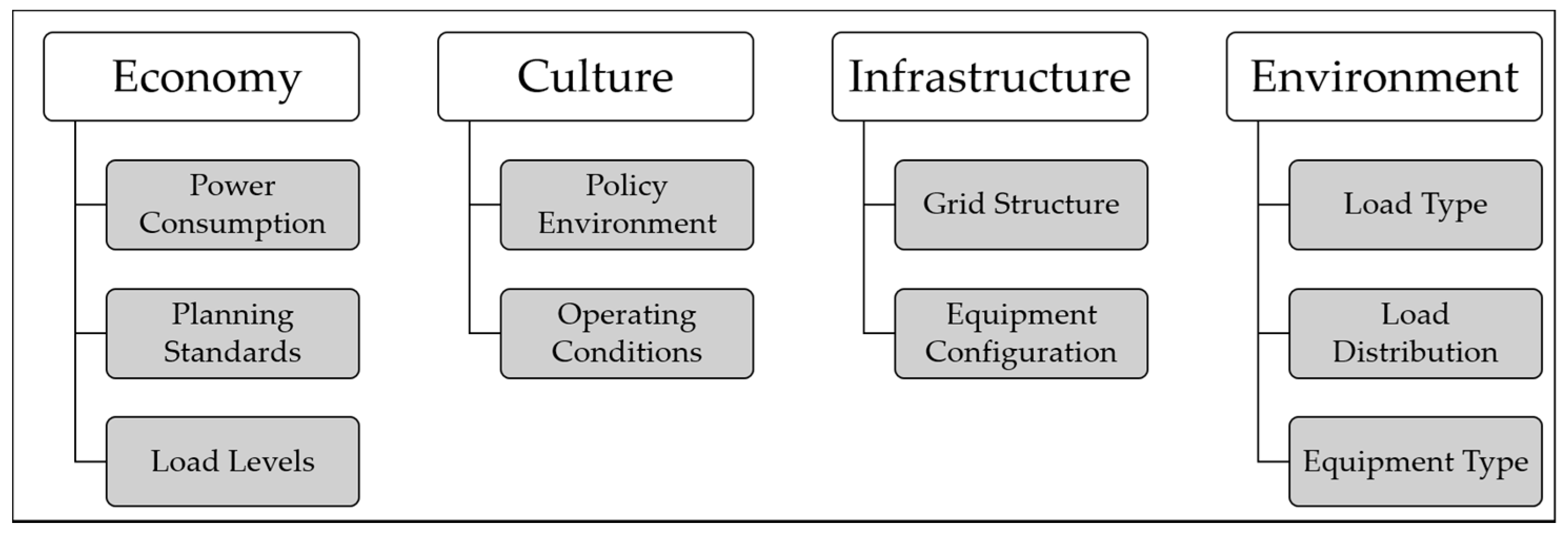


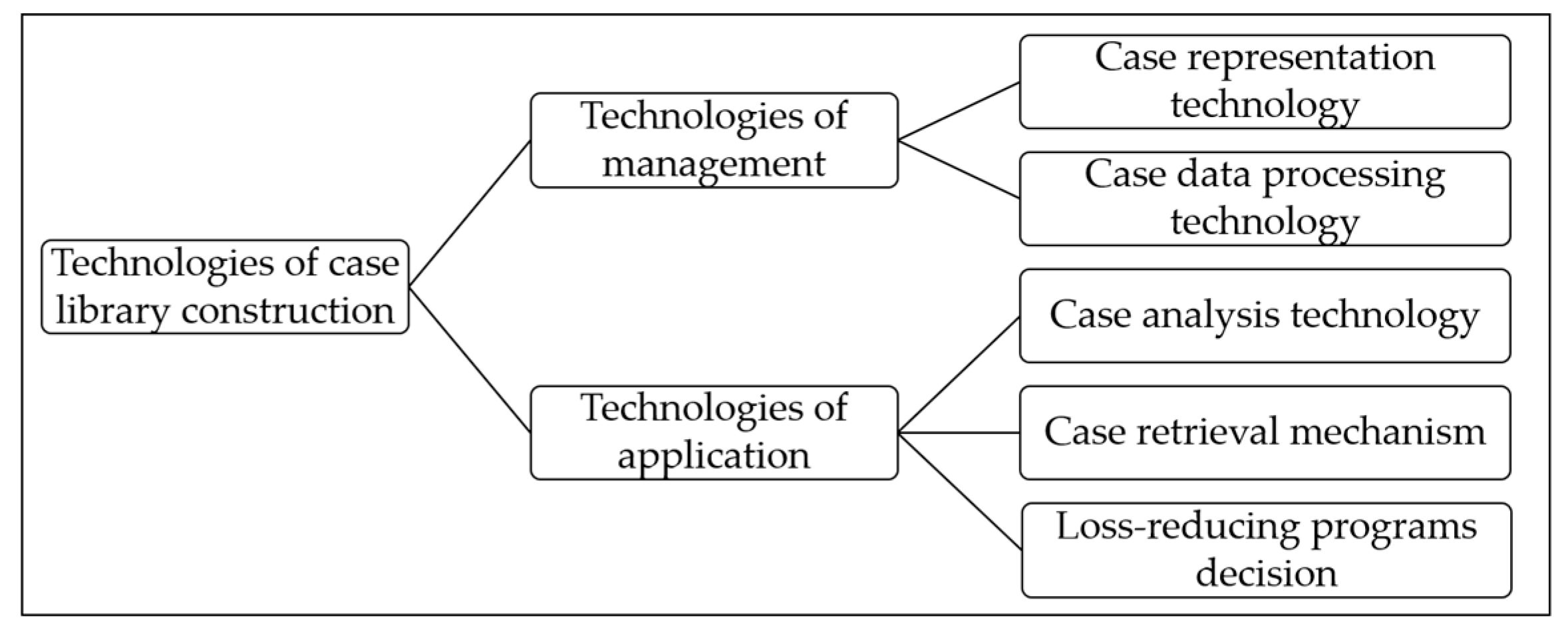
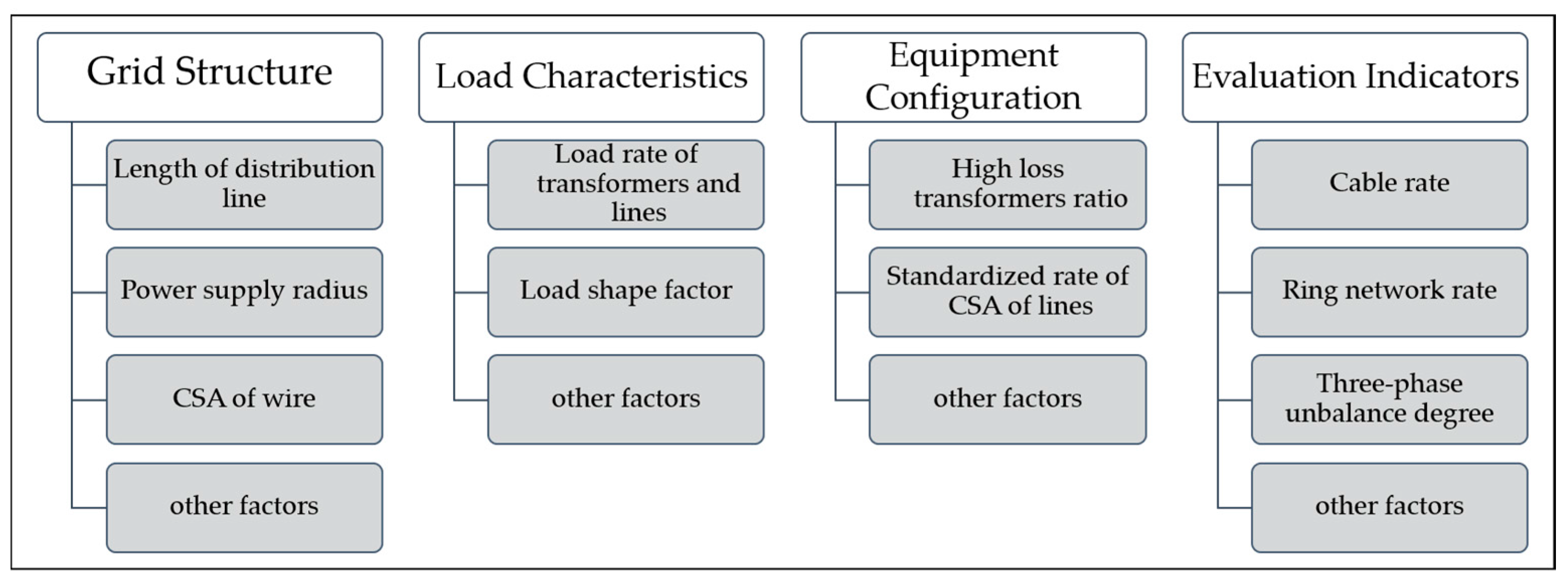


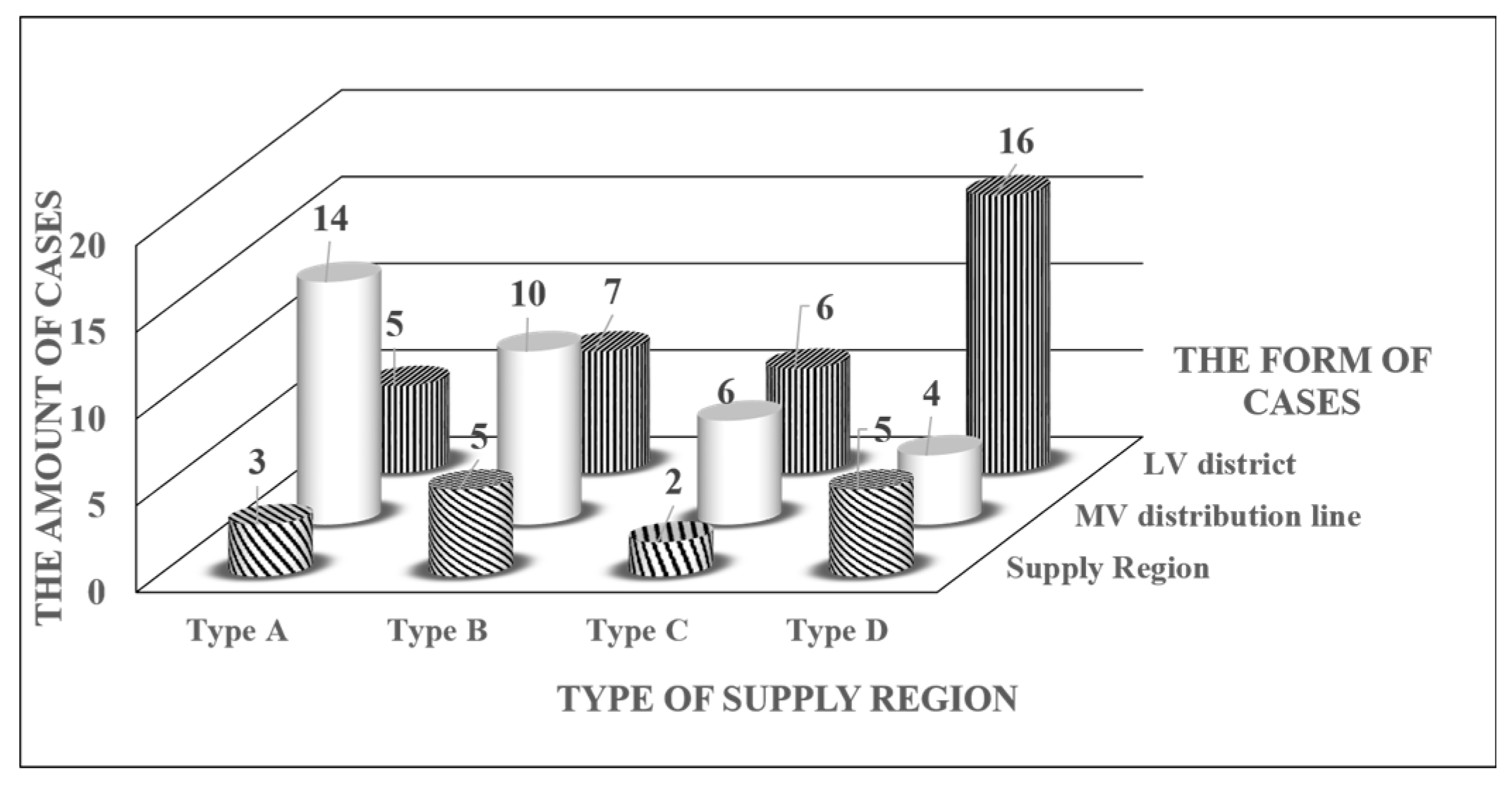


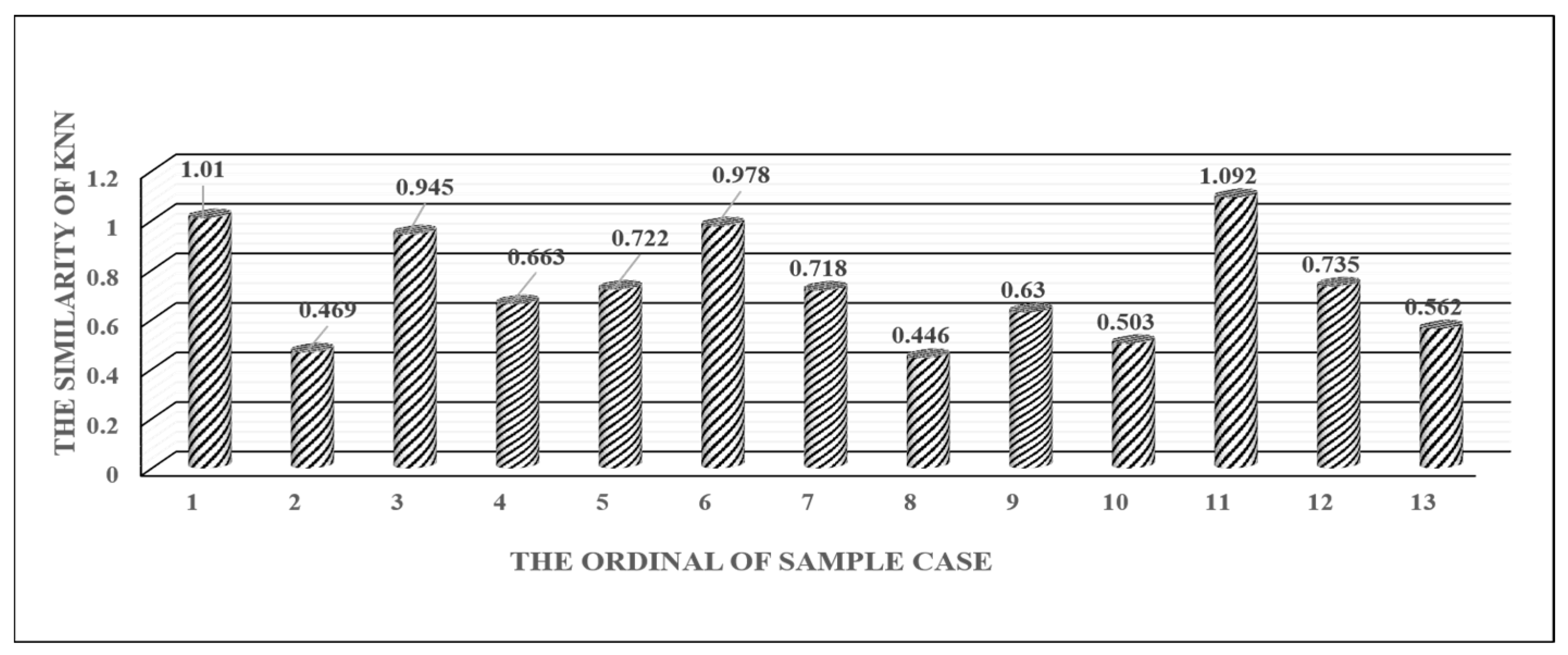
| Voltage Level | Magnitude of Voltage Included | The Corresponding Form of Case |
|---|---|---|
| High Voltage (HV) | 35~110 kV | Supply region |
| Medium Voltage (MV) | 6~10 kV | MV distribution line |
| Low Voltage (LV) | 0.38 kV | LV transformer district |
| The Form of Cases | The CSVs for Case Representation |
|---|---|
| Supply region | Average distribution line length; cable rate; ring network rate; Average load rate of distribution transformers; average load rate of distribution lines; standardized rate of the cross-sectional area (CSA) of lines. |
| MV distribution line | Power supply radius(α) 1; average load rate of MV distribution line(δ); average power factor of MV distribution line (ε); average load rate of distribution transformers(ζ); average power factor of distribution transformers(η); voltage qualified rate(θ). |
| LV transformer district | Power supply radius 2; CSA of LV wires; power factor of LV distribution lines; average load rate of LV distribution lines; load shape factor; three-phase unbalance degree. |
| The Type of Data | The Sources of Data | The Data Specification |
|---|---|---|
| Basic data of supply region | The offering report forms and program schedules | a. The type and number of supply region; b. loss-reducing programs implemented in a county; c. the historic data of energy loss. |
| Constructional data of distribution networks | The electric diagrams and spreadsheet | a. The specific data of electric equipment, including overhead line, power cables, distribution transformers and so on; b. the electric diagrams of distribution networks in various voltage classes. |
| Operating data of distribution networks | The historic monitoring data of smart meters in representative days | a. The load curves in representative days; b. the parameters which is related to the energy loss include voltage curve, current curve, power factor, apparent power and power consumption, etc. |
| The Types of Supply Regions | The Average Grey Relational Factors of CSVs | |||||
|---|---|---|---|---|---|---|
| α | δ | ε | ζ | η | θ | |
| Type A | 0.664 | 0.649 | 0.720 | 0.717 | 0.702 | 0.657 |
| Type B | 0.763 | 0.749 | 0.725 | 0.813 | 0.730 | 0.740 |
| Type C | 0.717 | 0.764 | 0.755 | 0.722 | 0.764 | 0.644 |
| Type D | 0.744 | 0.701 | 0.742 | 0.789 | 0.758 | 0.688 |
| The Ordinal of Analysis Scenes | Energy Loss Rate (%) | The CSVs in Analysis Scenes | |||||
|---|---|---|---|---|---|---|---|
| α (km) | δ (%) | ε | ζ (%) | η | θ (%) | ||
| 1 | 5.26 | 2.1 | 68.97 | 0.91 | 20.66 | 0.92 | 99.8 |
| 2 | 5.17 | 2.15 | 69.23 | 0.91 | 21.65 | 0.88 | 99.9 |
| 3 | 5.41 | 2.25 | 58.89 | 0.94 | 17.81 | 0.94 | 100 |
| 4 | 5.55 | 2.4 | 57.03 | 0.88 | 18.29 | 0.83 | 100 |
| The Ordinal of the Sample Cases | The Symbols for the CSVs | |||||
|---|---|---|---|---|---|---|
| α | δ | ε | ζ | η | θ | |
| 1 | 0.778 | 0.587 | 0.736 | 0.567 | 0.743 | 0.778 |
| 2 | 0.599 | 0.742 | 0.649 | 0.683 | 0.712 | 0.567 |
| 3 | 0.743 | 0.626 | 0.585 | 0.850 | 0.589 | 0.709 |
| 4 | 0.723 | 0.680 | 0.714 | 0.663 | 0.711 | 0.506 |
| 5 | 0.639 | 0.542 | 0.932 | 0.695 | 0.741 | 0.687 |
| 6 | 0.614 | 0.531 | 0.648 | 0.597 | 0.641 | 0.693 |
| 7 | 0.546 | 0.546 | 0.630 | 0.659 | 0.692 | 0.592 |
| 8 | 0.583 | 0.663 | 0.761 | 0.660 | 0.813 | 0.592 |
| 9 | 0.521 | 0.625 | 0.680 | 0.712 | 0.731 | 0.700 |
| 10 | 0.788 | 0.778 | 0.778 | 0.901 | 0.638 | 0.561 |
| 11 | 0.778 | 0.569 | 0.589 | 0.778 | 0.616 | 0.778 |
| 12 | 0.653 | 0.625 | 0.778 | 0.671 | 0.630 | 0.698 |
| 13 | 0.778 | 0.778 | 0.775 | 0.778 | 0.796 | 0.778 |
© 2017 by the authors. Licensee MDPI, Basel, Switzerland. This article is an open access article distributed under the terms and conditions of the Creative Commons Attribution (CC BY) license (http://creativecommons.org/licenses/by/4.0/).
Share and Cite
Yuan, Z.; Wang, W.; Peng, J.; Liu, F.; Yang, J. Case Library Construction Technology of Energy Loss in Distribution Networks Considering Regional Differentiation Theory. Energies 2017, 10, 1861. https://doi.org/10.3390/en10111861
Yuan Z, Wang W, Peng J, Liu F, Yang J. Case Library Construction Technology of Energy Loss in Distribution Networks Considering Regional Differentiation Theory. Energies. 2017; 10(11):1861. https://doi.org/10.3390/en10111861
Chicago/Turabian StyleYuan, Ze, Weizhou Wang, Jing Peng, Fuchao Liu, and Jianhua Yang. 2017. "Case Library Construction Technology of Energy Loss in Distribution Networks Considering Regional Differentiation Theory" Energies 10, no. 11: 1861. https://doi.org/10.3390/en10111861




